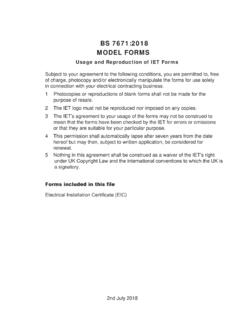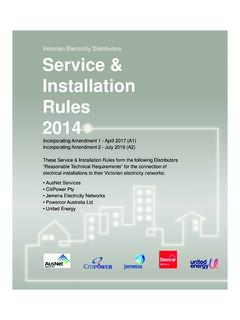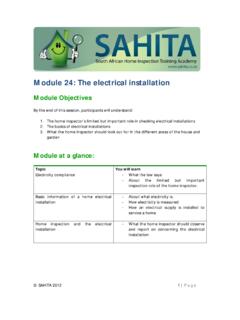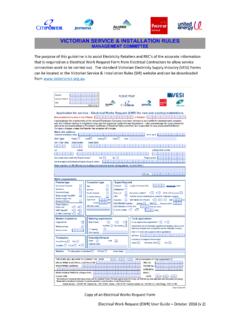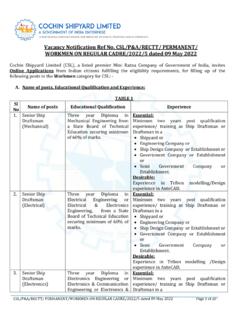Transcription of ELECTRICAL INSTALLATION OF RESIDENTIAL BUILDINGS …
1 Riga Technical University Institute of Power Engineering Department of Electric Power Supply ELECTRICAL INSTALLATION OF. RESIDENTIAL BUILDINGS . Methodical Guidelines for Practical Works RTU Press Riga 2019. K. B rzi a. ELECTRICAL INSTALLATION of Residen- tial BUILDINGS . Methodical Guidelines for Practical Works. Riga, RTU Press, 2019, 42 p. These methodological guidelines for practical works have been developed for students of the course ELECTRICAL INSTALLATION of RESIDENTIAL BUILDINGS . It is a methodologi- cal material containing theoretical descriptions and design methodology for practical assignment as prescribed in the course programme. The study material has been developed for regular, external, and part-time students of ELECTRICAL power engineering studies. The material includes the assignments, methodological materials, final examination materials developed and col- lected by the Department of Electric Supply.
2 Prepared by Associate Professor Dr. sc. ing. K. B rzi a. Reviewed by Associate Professor Dr. sc. ing. A. Podgornovs Proofreading: Daina Ostrovska Design: Baiba Puri a Cover Design: Paula Lore Cover picture from Published within the activity Enhancement of the mobil- ity and employability of Lithuanian and Latvian specialists in the field of ELECTRICAL engineering and high voltage tech- nologies (LitLatHV) . Riga Technical University, 2019. ISBN 978-9934-22-155-2 (pdf). Contents 4. 1. OBJECT STRUCTURE AND ARRANGEMENT. IN THE CONSTRUCTION 6. 2. GENERAL PLAN OF THE 8. 3. CIRCUIT DIAGRAMS OF WIRING IN THE RESIDENTIAL 9. 4. DETERMINATION OF THE DESIGN POWER IN A NETWORK. WITH UNEVENLY LOADED 9. 5. SELECTION OF LOW-VOLTAGE ELECTRICAL 11. Selection of low-voltage Selection of the main switchgear 12.
3 Selection of current transformers and electricity meters.. Selection13 of current transformers and electricity meters Selection of low-voltage 14. Selection of protective circuit 15. Calculation of three-phase short-circuit 16. Calculation of single-phase short-circuit 17. Example of drawing up selectivity 19. Selection of 21. Selection of low-voltage load 21. Selection of Selection of Selection of earthing Explication of 6. TYPES OF ELECTRICAL INSTALLATION AND WIRING METHODS .. 26. Special conditions.. 27. Wiring peculiarities .. 27. Wiring in bathroom and shower room ..27. Wiring heights ..28. Special room for engineering communication leads ..28. Number of sockets and lamps according to the accommodation type ..29. 7. GRAPHICAL 30. List of 31. Annex 32. Annex 38. 3. Introduction INTRODUCTION.
4 The task of a practical assignment is to develop wiring for a RESIDENTIAL building and to include an auxiliary building in the plan. The feeder link is an overhead or cable line that enters the house from East/West/South/North. Supply voltage: 400/230 V. Step-by-step plan: draw up the general plan;. draw the electric supply part of the axonometric drawing of the RESIDENTIAL house;. select fixed and mobile power using equipment and include a tankless water heater (17 kW);. draw up the abridged circuit diagram of the RESIDENTIAL building ;. calculate design power for each of the groups of the main switchgear and the house lead;. select the necessary elements of the wiring system;. calculate voltage deviation at one of the electrically most distant INSTALLATION points and assess its admissibility.
5 Draw wiring plans for all floors of the RESIDENTIAL building (in the basement, the wiring shall be installed above the plaster, while on all other floors under the plaster);. write down the step-by-step plan for mounting a lamp / socket on a brick/wooden surface. Additional task: draw connection circuit of a meter. Figure 1 represents the structure of an electricity supply project of a RESIDENTIAL house. 4. Introduction Content of electricity supply project of a RESIDENTIAL house Text Graphical part Title page General plan Composition of the Storey layout plan with power construction plan lines Storey layout plan with lighting Content system Roof plan with lightning Design assignment protection Merchant's registration Circuit diagrams of certificate switchgears Cross-sections of rooms and Certificate power network nodes Explanatory memorandum Description of the electricity supply source of object according to the technical requirements Information on the number and installed power of installed equipment Requirements for power supply reliability and selection of a back-up power supply source Description of routing lighting and emergency lighting system Description of lightning
6 Protection and overvoltage protection Calculations Calculation of design load Calculation of short-circuit currents Selection of ELECTRICAL appliances Calculation of earthing Calculation of lighting General indicators Specification of materials and works Fig. 1. Optimised structure of an electricity supply project of a RESIDENTIAL house. 5. 1. Object structure and arrangement in the construction site 1. OBJECT STRUCTURE AND ARRANGEMENT. IN THE CONSTRUCTION SITE. The explanatory note shall provide information on the following: 1) geographical arrangement of the section;. 2) object's address;. 3) area of the house;. 4) access roads;. 5) options of electricity supply;. 6) installed electric power P = .. kW, cos = .., earthing network: TN-C/TN-S/. TNC-S;. 7) outer walls and partition walls of the building .
7 8) location of furniture (freely selected). Functional use of BUILDINGS and description of the electric power: power of the fixed and mobile using equipment located in the RESIDENTIAL building . The RESIDENTIAL building is a one-storey/two-storey building with/without basement. The total usable area of prem- ises: . m2. The following ELECTRICAL appliances are located in the house: washing machine: P = . kW;. dishwashing machine: P = . kW;. small technological kitchen device: . kW, . kW, . kW, . kW, . kW;. refrigerator: P = . kW;. electric stove: P = . kW;. tankless water heater: P = . kW;. electric motor for opening the garage gate: P = . kW;. other fixed using equipment: . kW, . kW, . kW, . kW, . kW. Examples of fixed using equipment are given in Table 6. 1. Object structure and arrangement in the construction site Table Possible power of using equipment and location of the equipment in premises Room No.
8 (explications) Room type Using equipment cos j P, kW. Entrance LED bulbs Hall Router LED bulbs Auxiliary room Boiler Washing machine LED bulbs Dining room/kitchen Teapot Refrigerator Coffee machine Cooker hood Microwave oven Electric stove LED bulbs Household room iRobot LED bulbs Living room TV set DVD Decoder Mobile phone charger LED bulbs Room Lamp Computer Table lamp LED bulbs Table lamp LED bulb Bathroom Hair dryer Electric razor LED bulb Fan Garage/shed/greenhouse LED bulb 7. 2. General plan of the object 2. GENERAL PLAN OF THE OBJECT. Table Explication of BUILDINGS and structures No. in the Name of the structure Area, m2 Notes plan 1 RESIDENTIAL building Puzst = , cos j = . 2 Sauna Puzst = , cos j = . 3 Garage Puzst = , cos j = . 4 Shed Puzst = , cos j = . 5 Greenhouse Puzst = , cos j =.
9 Fig. General plan of the object. 8. 3. Circuit diagrams of wiring in the RESIDENTIAL building 3. CIRCUIT DIAGRAMS OF WIRING IN THE. RESIDENTIAL building . A1 switchgear must comply with the requirements of AS Sadales t kls and must be located outside the object's territory so that it is easy accessible by an inspector. A1 meter- ing switchgear feeds the main switchgear A2 of the house from which the main cables to group switchgears lead according to the assignment variant. Cable routes shall be installed under the plaster everywhere. Lighting systems and socket network shall be designed to be separate. See an example of the circuit diagram in Annex 2. DESIGN PART. 4. DETERMINATION OF THE DESIGN POWER IN A. NETWORK WITH UNEVENLY LOADED PHASES. When designing electricity supply to a RESIDENTIAL building , design power for both separate groups of the switchgear and the feeding lead in general must be determined, considering the existing or planned using equipment.
10 Three-phase, two-phase, and single- phase using equipment can be connected to three-phase switchgears (Fig. ). The power of single-phase and two-phase using equipment can be divided unevenly. In this case, the equivalent three-phase power in the building lead is calculated using single-phase and two-phase consuming units. Real power is calculated as follows: Pen = 3 Pnmf , ( ). where Pen equivalent real three-phase power from unevenly loaded phases, W;. Pnmf real power of the phase loaded mostly by the using equipment connected to two-phase and single-phase voltage, W. Pnmf = Pfi + Pflin, ( ). i where i Pfi total power that is connected to the voltage of the maximum loaded phase, W;. Pflin power of the maximum loaded phase that is gained from two-phase using equipment, W. It can be calculated using the following equations ( ) ( ): P + PL3,1.
